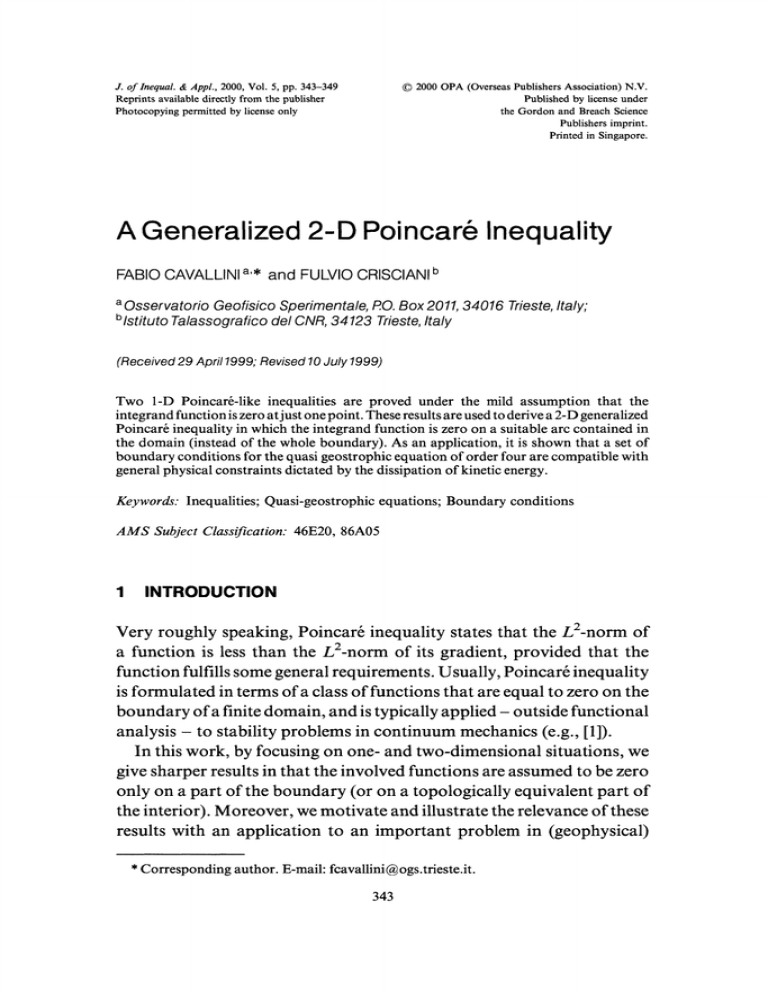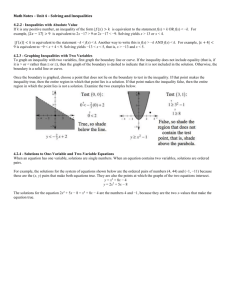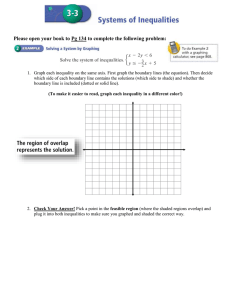Document 10943983
advertisement

(C) 2000 OPA (Overseas Publishers Association) N.V.
Published by license under
the Gordon and Breach Science
Publishers imprint.
Printed in Singapore.
J. of Inequal. & Appl., 2000, Vol. 5, pp. 343-349
Reprints available directly from the publisher
Photocopying permitted by license only
A Generalized 2-D Poincar6 Inequality
FABIO CAVALLINI a.. and FULVIO CRISCIANI b
aOsservatorio Geofisico Sperimentale, RO. Box 2011, 34016 Trieste, Italy;
b
lstituto Talassografico del CNR, 34123 Trieste, Italy
(Received 29 April 1999; Revised 10 July 1999)
Two 1-D Poincarr-like inequalities are proved under the mild assumption that the
integrand function is zero at just one point. These results are used to derive a 2-D generalized
Poincar6 inequality in which the integrand function is zero on a suitable arc contained in
the domain (instead of the whole boundary). As an application, it is shown that a set of
boundary conditions for the quasi geostrophic equation of order four are compatible with
general physical constraints dictated by the dissipation of kinetic energy.
Keywords." Inequalities; Quasi-geostrophic equations; Boundary conditions
AMS Subject Classification: 46E20, 86A05
1
INTRODUCTION
Very roughly speaking, Poincar6 inequality states that the L2-norm of
a function is less than the LE-norm of its gradient, provided that the
function fulfills some general requirements. Usually, Poincar6 inequality
is formulated in terms of a class of functions that are equal to zero on the
boundary of a finite domain, and is typically applied outside functional
analysis to stability problems in continuum mechanics (e.g., [1]).
In this work, by focusing on one- and two-dimensional situations, we
give sharper results in that the involved functions are assumed to be zero
only on a part of the boundary (or on a topologically equivalent part of
the interior). Moreover, we motivate and illustrate the relevance of these
results with an application to an important problem in (geophysical)
* Corresponding author. E-mail: fcavallini@ogs.trieste.it.
343
F. CAVALLINI AND F. CRISCIANI
344
fluid dynamics, namely, that of finding physically admissible boundary
conditions for the quasi-geostrophic equations when the turbulence is
parametrized by means oflateral diffusion ofvorticity, thus giving rise to
fourth-order spatial derivatives.
POINCARI INEQUALITIES WITH NONZERO
BOUNDARY CONDITIONS
In the following lemmata, a prime (’) denotes differentiation.
LEMMA
If c [a, b]
given c E [a, b], then
-
is a smooth function such that q[c]
b
f b2[
x] dx _< 4(b a) 2
fa (b’[x] )
dx.
Proof Using the assumption b[c] O, we get the identity
x
42[x]
Vx E [a, b].
2
Hence, because of Schwarz inequality,
1/2
b2[x] _< 2
and, afortiori,
_
x(,)
2
1/2
Integrating with respect to x, we obtain
fab
O2 2(b a)
(fab qb2) (ab(t)2) l/2.
l/2
Simplifying and squaring yields inequality (1).
0 for a
(1)
GENERALIZED 2-D POINCARI INEQUALITY
q[c]
If 0 < a,
and dp :[a, b]
0for a given e E [a, b], then
LEMMh 2
b
345
N is a smooth function such that
b
C2[X] x dx < 4 a (b a)
(b’[x])x dx.
(2)
Proof From the obvious inequality
fa 6
[x]x x <_ b
fa
[x] x
we get, using Lemma 1,
f
b
bZ[x] x dx _< 4b(b a) 2
fab
(4[x] ) dx.
The integral in the right-hand side of this inequality may be estimated as
b
(’[x]) 2 dx _< a
fab (’[x])2x
dx.
Our claim follows from the last two inequalities.
The following Theorem is the main mathematical result of this
paper. Its statement, perhaps a little obscure at a first reading, becomes
much clearer after looking at Fig. 1. Point c of Fig. 1, although not
explicitly mentioned in Theorem 1, corresponds to point c of Lemma
and Lemma 2. Obviously, any bounded convex domain D satisfies the
assumptions of Theorem 1.
Let D C 2 be a bounded set whose boundary OD is a Jordan
curve. Assume there is a point 0 external to OD such that the intersection
between D and any line through 0 is either empty or a segment. Assume
further that there is a continuous arc AB C D such that the angle A OB
contains D. Then there is a constant C such that
THEOREM
(3)
for any smooth function equal to zero on arc AB.
F. CAVALLINI AND F. CRISCIANI
346
FIGURE
Heuristic illustration of the symbols appearing in the statement of
Theorem 1. In the application to quasi-geostrophic equations, the curved arcs (straightline segments) in the boundary of D represent the coastlines (zonal boundaries where
the wind forcing vanishes) of the subtropical North Atlantic ocean.
Proof Let (r, 0) be polar coordinates with origin O, and let [a, b] denote
the intersection (when nonempty) of D with a straight line through O,
where a a[O] and b b[O]. Defining [r, 0] [r cos[0], r sin[0]], we may
apply Lemma 2 to the function r H [r, 0] obtaining
b[0]
2[r, O]r dr < K[O]
./a[0l
r dr,
da[O
where
K[O]
4
b[O]
[0] (b[0]- a[0]) 2.
Hence, a fortiori,
fb[ol
[r, O]r dr dO < gmax
,I a[O]
Ja[O]
+
where Kmax is the constant defined by
Kmax
max{K[O]: O _< 0 _< Os},
-
r dr dO,
which is well defined because O is assumed to be external to OD. Passing
from polar to Cartesian coordinates in the last inequality, our claim.
follows with C- Kmax.
GENERALIZED 2-D
3
POINCARI INEQUALITY
347
AN APPLICATION TO OCEAN CIRCULATION
The large-scale circulation in the upper oceanic layer is described by the
quasi-geostrophic equation [2, p. 32]
0
O
0-7 v2 + J[’’ v2 ] + b-Yx (curl
(4)
b [x, y] is the stream function, J is the Jacobian (or Poisson
bracket) operator defined by J[a, b] div[aVb x k], is wind stress, R
where
and e are positive constants, is time, and x, y, z are Cartesian coordinates
with k the unit vector along z-direction. Since Eq. (4) is of order four
in space, one more boundary condition is needed besides the obvious
no-mass flux condition:
o, V{x,y} e oz:,,
e[x, y, t]
vt.
The problem of finding a physically appropriate auxiliary (so-called
"dynamic") boundary condition is far from being trivial, because
boundary conditions affect also the qualitative behavior of the flow,
which must fulfill general energy-related constraints. In the following, we
shall use Theorem to show that, if the "ocean" D satisfies the
assumptions of Theorem (see also Fig. 1), then the solution arising
from the mixed boundary condition
0
o-V%
o
V2b= 0
on the coastline,
(6)
on the sea boundary
(7)
successfully passes the following tests:
(1) The kinetic energy of any flow is bounded if the forcing term is in L2.
(2) The kinetic energy of any flow with zero forcing tends to zero
for t---, oc.
Multiplying Eq. (4) by the relative vorticity
the domain D, we have
N+R
J[g" ’] +
xx
72, and integrating over
(curl r)z + e
.
(V:z( (8)
-
F. CAVALLINI AND F. CRISCIANI
348
We see immediately that
(
(9)
(
Straightforward computations (using the identity bJ[a, b] J[a, b2]/2
and the 2-D divergence theorem div fOP n. with boundary condition (5)) show that
fD
( J [, (]-0.
(10)
V
Integrating over D the identity
div(V)- 1712, applying the
2-D divergence theorem, and using our mixed boundary conditions
yields
fD " V2" fD
IVy’] 2
(11)
Substituting Eqs. (9)-(11) into Eq. (8) gives
(ur-r)
x
mot
IVl
.
(12)
Integrating over D the identity
and applying Green’s formula
condition (5), we get
&p
fz Ox fop dy, together with boundary
o-= j
dylWPl > 0.
(13)
From (12) and (13), using Theorem 1, we obtain
0
20t
2<
(curlr)z
We point out that in this case the arc AB of Theorem coincides with
segment AB of Fig. 1, where ( 0 because of (7). Denoting the L2-norm
GENERALIZED 2-D
POINCARI INEQUALITY
349
by II’ll, using the Schwarz inequality, and simplifying, the previous
relation may be rearranged as
which implies
II[t]ll
exp
e
-t
I1[0]11
--
C
(curl )zll
+--II (curl
On the other hand Crisciani and Purini [3] show that
E[t]
I[[t]ll
=,
E[t]=(1/2)llX7b[t]l[ 2 represents the
kinetic energy, and A is a
constant. From the last two inequalities we get
where
E[t] <__
(
exp
e
]( II[0]ll
Cll(curlr)zll )
/-II (curl r)zll
and hence
-
limE[t] =1
(Cll(curl)ll
whence we immediately deduce that our mixed boundary condition has
successfully passed both the tests previously stated.
References
[1] M.E. Gurtin, An Introduction to Continuum Mechanics, Academic Press, New York
(1981).
[2] J. Pedlosky, Ocean Circulation Theory, Springer-Verlag, Berlin, Heidelberg (1996).
[3] F. Crisciani and R. Purini, A stability condition for planar flows not satisfying the
Blumen-Pedlosky criterion,//Nuovo Cimento D 11, 1677-1684 (1998).





